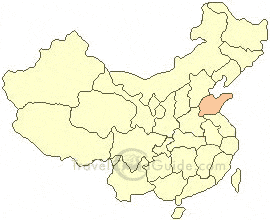
Shandong Province, China
Posted on 05/11/2005 11:11:18 AM PDT by blam
Earliest states possibly in shape 5,000 years ago
www.chinaview.cn 2005-05-11 15:56:15
JINAN, May 11 (Xinhuanet) - Dozens of prehistoric states might have been developing in eastern China as early as 5,000 years ago,thousands of years before the birth of the first textually attested state that existed in Xia Dynasty (2100 B.C.-1600 B.C.), said a Sino-US archaeological research team.
The presumption was based on a decade-long regional survey and excavation in Rizhao, a coastal city in east China's Shandong Province. Archaeologists with the team are almost sure they have identified the ruins of a prehistoric state dating back between 3,000 B.C. and 2,200 B.C.
The population of the state was roughly 63,000, and the size of its capital might have an area as large as one million square meters, said Fang Hui, a member of the team and professor in the archaeology department at the Shandong University based in Jinan, the provincial capital.
Legends put the origin of the Chinese civilization at 5,000 years ago but archaeologists could hitherto only prove the earliest state in China was born in central Henan Province some 3,000 years ago.
"Many writers, from all countries, focus on remains from HenanProvince, where the Xia and Shang dynasties (2100 B.C.-1100 B.C.) developed. But we found that societies with complex social and political organizations also existed in southeastern Shandong," said Dr. Anne Underhill, member of the team and research fellow with the Field Museum in Chicago.
The Sino-US team began the regional survey at Rizhao in 1995. They had found a Neolithic site, the Liangchengzhen site, that could date back to 2,600 B.C. at 30cm below the surface of farmland in the outskirts of Rizhao, covering an area of one million square meters.
But they said pottery sheds were spread around an area of 2.56 million square meters. Fang Hui said the site was believed to be the capital of the ancient state and was secured by three layers of defense walls. The inner wall enclosed an area of more than 200,000 square meters, which scholars believed was a political center at the time.
"Our survey data do show a clear settlement hierarchy. Liangchengzhen is the largest site, and there are many smaller sites clustered near it," Dr. Underhill said.
It is possible that leaders controlled the flow of prestigious pottery vessels in the region."
"Probably most of these vessels were made at Liangchengzhen, since it appears the quality of the clay in the region is better than elsewhere, and the greatest variety of fancy vessels is at this site," she added.
"The society at the time did have a hierarchy with leaders at the top and farmers at the grassroots. It was a big difference from the prehistoric times when people lived equally," said Luan Fengshi, professor with the research institute of archaeology under the Shandong University.
The archaeologists identified the remains of about 40 ancient houses shaped like circles, squares, and rectangles, with remains of stoves and doorsteps inside. They also found over 50 rectangle-shaped tombs, scattered around the formal residential area.
Thousands of excavated pottery sheds are thought to have been parts of cooking or drinking vessels, or sacrificial utensils. Other excavated relics included hunting tools such as stone chisels and arrowheads, spinning tools and medical instruments. Fang Hui said such prehistoric states might also have existed in the eastern Jiangsu and Zhejiang provinces.
Research findings indicated the society in parts of China underwent dramatic changes in the late Neolithic period some 4,000 years ago, he said.
However, the research team had to find enough evidence to prove that social hierarchies actually characterized the prehistoric social systems.
"It is very hard for archaeologists in any area of the world to find material remains to demonstrate that a state existed," said Dr. Underhill. I hope we can find enough evidence some day." End item
GGG Ping.

Shandong Province, China
One square kilometer doesn't sound like much anymore. That would rank in size and population about 750th of modern American municipal centers or 3000th of Chinese.
So, is it just me? or does the "out-of-Africa" speculations seem now to have been a bit premature?
Even the "fertile crescent" history I was taught as a youngster seems to me sillier and sillier with each new discovery.
14,000-year old South American settlements?
You do realize why, for instance, oil spills which used to be measured in "barrels" are now reported in "gallons"?
I think the evolution of reporting them in teaspoons is now overdue.
Think about it. Grants, funding, yada yada.
Who do you suppose will get the grant? The one who reports a million square meters for study or the one who claims merely one square kilometer?
Thanks for posting a map.
My house is large --- over 1 million cubic millimeters! ;~))
How about 50,000 years old in South Carolina, Topper.
That still doesn't change the 'out-of-Africa' theory.
Seems like whereever there were fertile plains with water available(ie rivers) , that often attracted early settlements of humans
LOL. Just like weeds!
Please FREEPMAIL me if you want on, off, or alter the "Gods, Graves, Glyphs" PING list --
Archaeology/Anthropology/Ancient Cultures/Artifacts/Antiquities, etc.
The GGG Digest -- Gods, Graves, Glyphs (alpha order)
bttt
All the original civilazations were wineries.
"That still doesn't change the 'out-of-Africa' theory."
You need to point him to the Y chromosome haplotype migration maps. It's the clincher for me. Goes way past speculation on bones, we are at the fact level now.
|
|
|
| GGG managers are SunkenCiv, StayAt HomeMother & Ernest_at_the_Beach | |

|
|
Just updating the GGG information, not sending a general distribution. |
|
|
|
|
Disclaimer: Opinions posted on Free Republic are those of the individual posters and do not necessarily represent the opinion of Free Republic or its management. All materials posted herein are protected by copyright law and the exemption for fair use of copyrighted works.